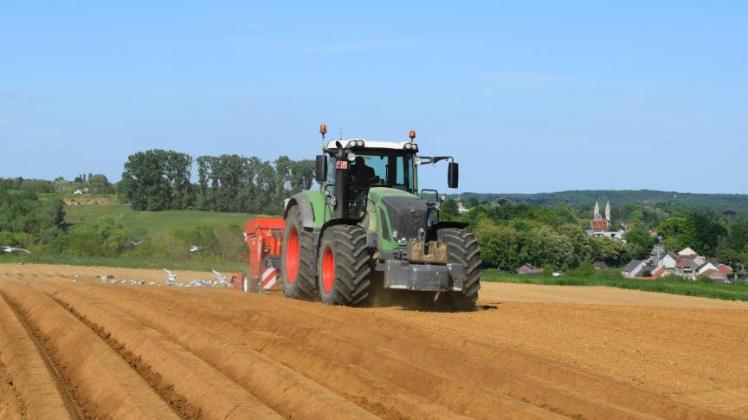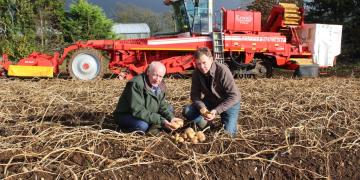Europe: Several reasons to be careful with potato cultivation
The NEPG (United Northern European Potato Growers) reminds growers again that they have to be careful with the cultivation of potatoes.

There are no official figures yet on the potato area (consumption/seed potatoes/starch), but the increase in the area of consumption potatoes (processing + fresh market) in the NEPG zone is provisionally estimated at 5%. This corresponds to approximately 25,000 ha. In the coming weeks it will become clear whether this estimate needs to be adjusted.
The total production will ultimately also depend on the yield per hectare achieved. Despite some rain in late May and early June, the drought remains a major problem. Growth was delayed and post-emergence herbicide treatments can also have an impact on the final yield.
Profitable alternatives for potato cultivation are scarce and the processing industry seems to be expanding further (most processors have plans for expansion). This encourages growers to expand strongly in potatoes. They can follow this trend to a certain extent, but should not get ahead of the facts.
Drastically falling potato prices
The sharp drop in potato prices (from 30 euros/100 kg at the end of February to 7.50 euros/100 kg now) is the result of several factors that developed more or less simultaneously, the NEPG states in a press release at the beginning of June.
Exports of frozen fries and other potato products started to slow down last year. Indeed, sales on the world market have declined. The sales volume of the NEPG zone (BE, DE, FR and NL) decreased by 1.8% between 2023 and 2024 (source: Eurostat). This is a historic decline, excluding the Covid crisis. The average sales price had increased by 64% between 2021 and 2023. It stagnated in 2024 and is even tending to decrease in 2025. Competition from the Asian markets is real: China and India have increased their exports tenfold in 5 years.
Not only did our production costs (cultivation and storage) continue to rise, but the prices for frozen European fries also rose and were higher than those in Canada, China, India or other newcomers in the processing world.
The new taxes and tariffs imposed by US President Trump have slowed or stopped European exports of processed products. This economic uncertainty has also weakened the US dollar and made European products more expensive.
In recent years, few other crops have been as profitable as potatoes. High prices on the free market in the spring of 2023 and 2024 (affecting only 5% of the harvest) made farmers believe that the low prices would not be repeated ...
Serious errors were made in processing part of the 2024 harvest, resulting in poor quality fries and poor sales.
The historically early 2025 planting season made the industry realise that the leftovers from 2024 production would weigh on the market.
The limited rain showers temporarily removed the spectre of a severe drought and ensured that potatoes could develop quickly in most regions. As a result, prices could not stabilize or increase.
The drought and warm weather have allowed potatoes to root well, potentially making them more resilient to periods of slowed growth.
Globalized world market
European producers are increasingly working in a globalised world market. Competition is fierce and the market is vulnerable. There are more and more players in different parts of the world. The market for processed products (mainly fries) is still growing, but competition from other global players is becoming increasingly important. Cooperation between the different links in the potato chain is essential if we want to improve our competitive position.
The production costs of European potato growers have been rising steadily in recent years. European prices for frozen potato products are higher than Canadian prices and even higher than Chinese or Indian prices, mainly due to higher energy and freight costs. Egyptian, Indian or Chinese chip factories can export to their neighbouring countries cheaper than European processors.
European potato growers are not only faced with higher production costs, but also with stricter regulations and numerous environmental challenges (crop protection, fertilization, water use, CO2, etc.). Climate change is also being felt more and faster on the European continent than in other parts of the world. Soil-related problems (nematodes, wireworms, sedge, etc.) and emerging diseases (e.g. Stolbur) also make it technically more difficult and financially risky to grow potatoes.
Profitability overrated
Growers may have overestimated the long-term profitability of potato cultivation. They should be aware of the pressure on cultivation and the need to find a good balance, the NEPG stresses. If not, the government will intervene with new legislation (longer rotation, cultivation ban in certain risk areas, etc.) and stricter legislation (use of crop protection products, fertilization, water, erosion, etc.)
Fuente: landbouwleven.be




